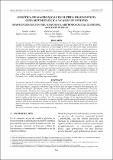Por favor, use este identificador para citar o enlazar este ítem:
https://hdl.handle.net/20.500.12958/3648Registro completo de metadatos
| Campo DC | Valor | Lengua/Idioma |
|---|---|---|
| dc.contributor.author | Arakaki, Natalia | - |
| dc.contributor.author | Carbajal Enzian, Patricia | - |
| dc.contributor.author | Marquez-Corigliano, Diego | - |
| dc.contributor.author | Suárez Alarcón, Sigfried | - |
| dc.contributor.author | Gil-Kodaka, Patricia | - |
| dc.contributor.author | Perez-Araneda, Karla | - |
| dc.contributor.author | Tellier, Florence | - |
| dc.date.accessioned | 2021-12-09T17:14:46Z | - |
| dc.date.available | 2021-12-09T17:14:46Z | - |
| dc.date.issued | 2021-12 | - |
| dc.identifier.citation | Arakaki N, Carbajal P, Marquez-Corigliano D, Suárez S, Gil-Kodaka P, Perez-Araneda K, Tellier F. 2021. Genética de macroalgas en el Perú: diagnóstico, guía metodológica y casos de estudio. Inf Inst Mar Perú. 48(4): 594-609 | es_ES |
| dc.identifier.issn | 0378-7702 | - |
| dc.identifier.uri | https://hdl.handle.net/20.500.12958/3648 | - |
| dc.description.abstract | Para promover el uso comercial de macroalgas en Perú hace falta tener mejor conocimiento de la estructura genética de las especies. La determinación taxonómica basada en criterios genéticos e identificación de áreas de diversidad genética particulares, tendrán consecuencias importantes para la conservación y manejo sustentable de esos recursos naturales. En este estudio se hace un diagnóstico de aportes al conocimiento de algas pardas y rojas registradas en Perú en los últimos 10 años: pelillo (Gracilariopsis, Agarophyton), aracanto (Lessonia), sargazo (Macrocystis), cochayuyo (Porphyra y Pyropia), yuyo (Chondracanthus), alga flor (Mazzaella) y carola (Callophyllis). Se propone una guía metodológica para realizar investigaciones genéticas, ilustrándola con cuatro casos de estudio. Para esto, se destacan los cambios taxonómicos del organismo estudiado los últimos años y se detallan métodos como: análisis filogenéticos y delimitación de especies. Finalmente se presentan resultados obtenidos y perspectivas futuras de las macroalgas reconocidas por su importancia comercial o por su potencial para usarse en la alimentación o industria: en el Perú: el “cochayuyo” ¿cuántos géneros y cuántas especies se comen?, el “yuyo” ¿son una o dos especies?, los “pelillos” ¿de dónde vienen?, ¿qué especies comparten las costas de Perú y Chile, en el caso de “sargazo” o ”aracanto”? | es_ES |
| dc.description.abstract | ABSTRACT: This study makes a diagnosis of the knowledge of brown and red algae recorded in Peru during the last decade: Gracilariopsis, Agarophyton, Lessonia, Macrocystis, Porphyra, and Pyropia, Chondracanthus, Mazzaella, and Callophyllis. Therefore, their taxonomic determination, based on genetic criteria and identification of areas where genetic diversity occurs will be important for their conservation and sustainable management to promote their commercial use in Peru. We also propose a methodological guideline for conducting genetic studies, with four case studies. Thus, the taxonomic changes of the organisms studied in recent years are highlighted and the methods to be used are detailed, which corresponds mainly to phylogenetic analyzes and species delimitation. Finally, we present the results obtained and the future perspectives of these macroalgae recognized for their commercial importance or for their potential to be used in food and industry. | - |
| dc.language.iso | spa | es_ES |
| dc.publisher | Instituto del Mar del Perú | es_ES |
| dc.relation.ispartofseries | Informe IMARPE 48(4), 2021; | - |
| dc.rights | info:eu-repo/semantics/openAccess | es_ES |
| dc.rights.uri | https://creativecommons.org/licenses/by/4.0/ | es_ES |
| dc.source | Instituto del Mar del Perú - IMARPE | es_ES |
| dc.source.uri | Repositorio Digital IMARPE | es_ES |
| dc.subject | Macroalgas | es_ES |
| dc.subject | Algas comerciales | es_ES |
| dc.subject | Genética | es_ES |
| dc.subject | Análisis molecular | es_ES |
| dc.title | Genética de macroalgas en el Perú: diagnóstico, guía metodológica y casos de estudio | es_ES |
| dc.title.alternative | Seaweed genetics in Peru: diagnosis, methodological guideline, and case studies | es_ES |
| dc.type | info:eu-repo/semantics/article | es_ES |
| dc.publisher.country | Perú | es_ES |
| dc.subject.ocde | http://purl.org/pe-repo/ocde/ford#1.06.03 | es_ES |
| Aparece en las colecciones: | Informe vol. 48(4) 2021 | |
Ficheros en este ítem:
| Fichero | Descripción | Tamaño | Formato | |
|---|---|---|---|---|
| Informe 48-4 articulo8.pdf | 1,8 MB | Adobe PDF |  Visualizar/Abrir |
Este ítem está sujeto a una licencia Creative Commons Licencia Creative Commons

